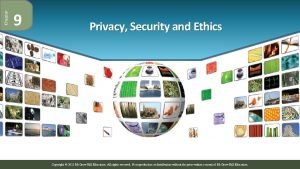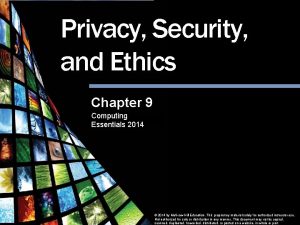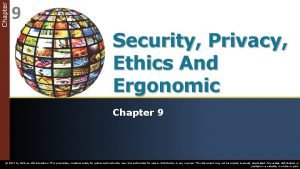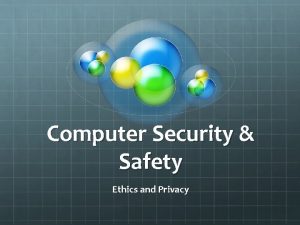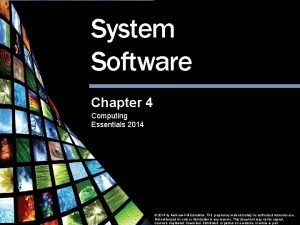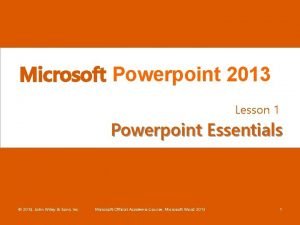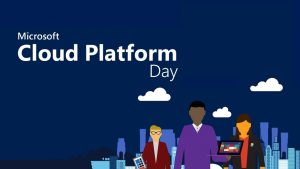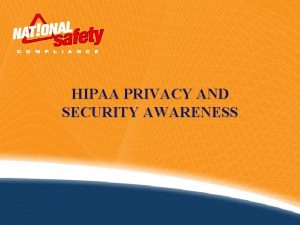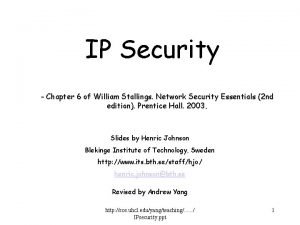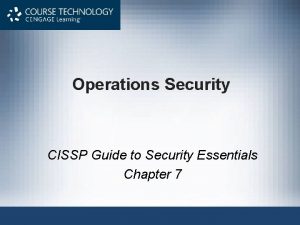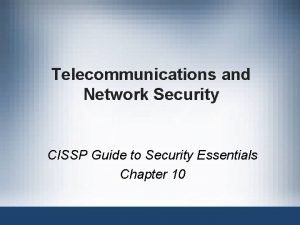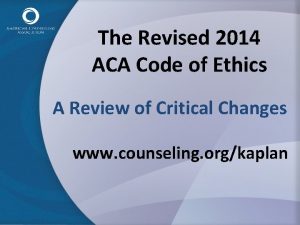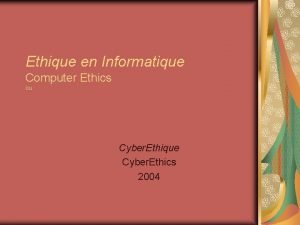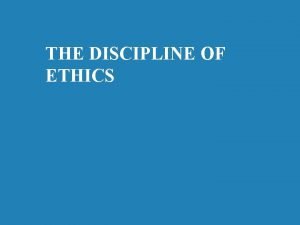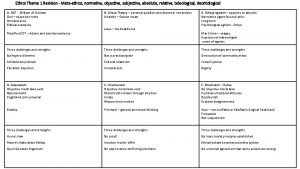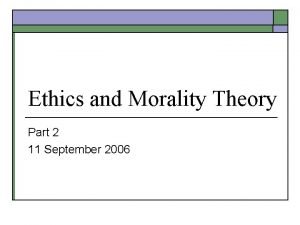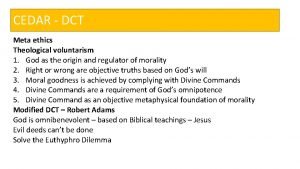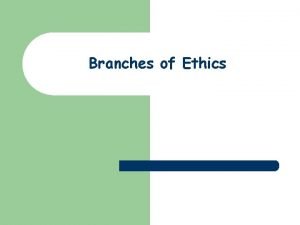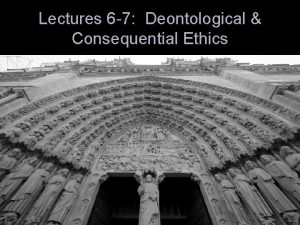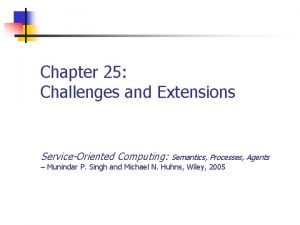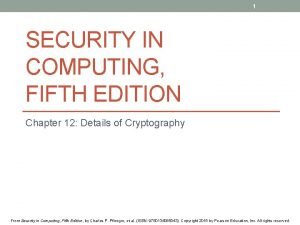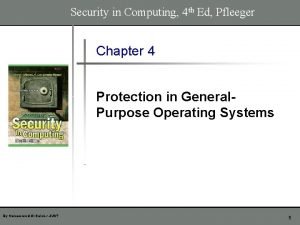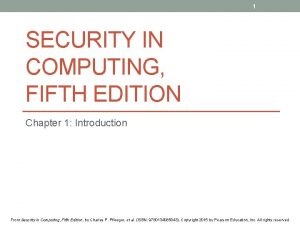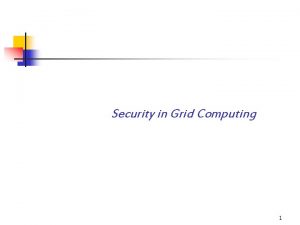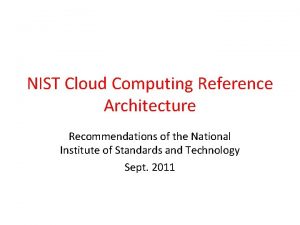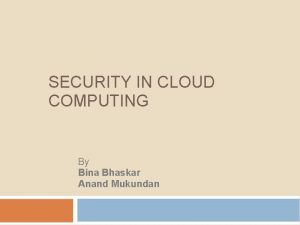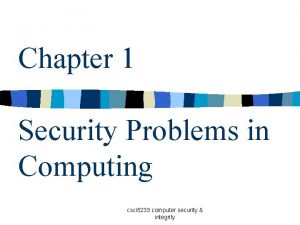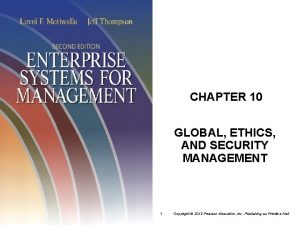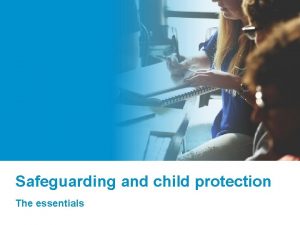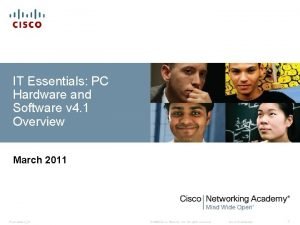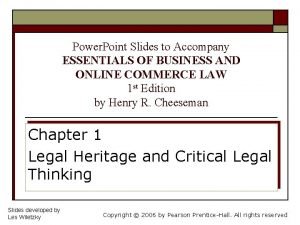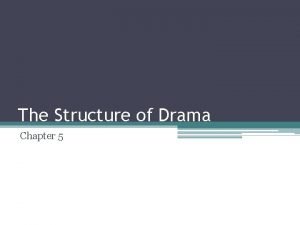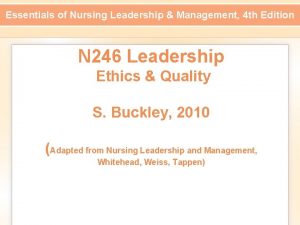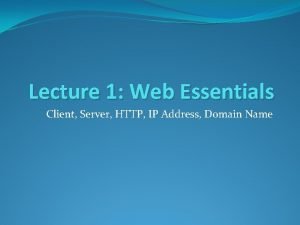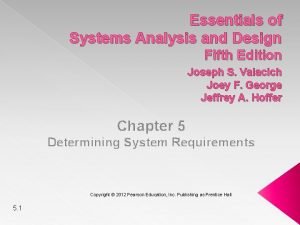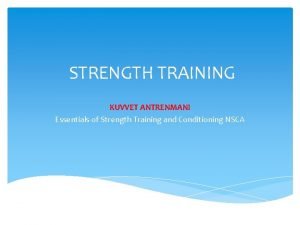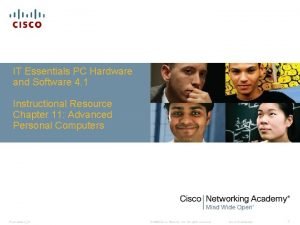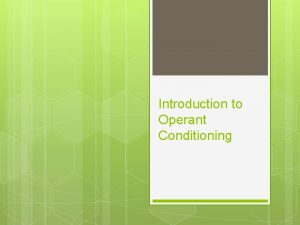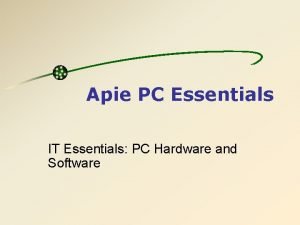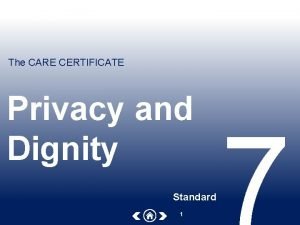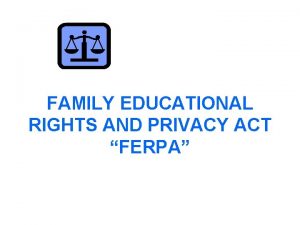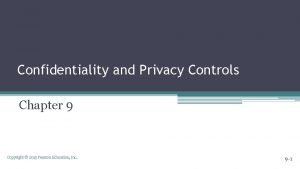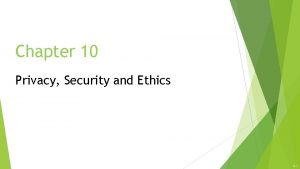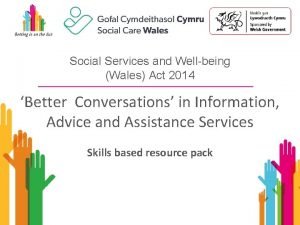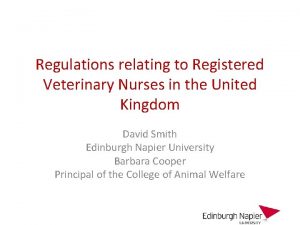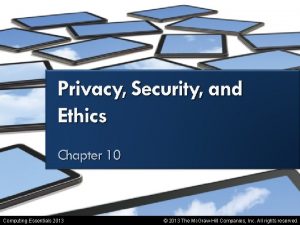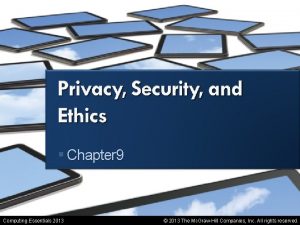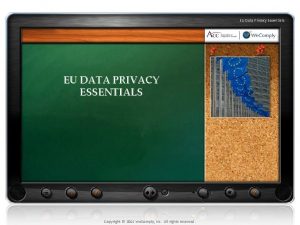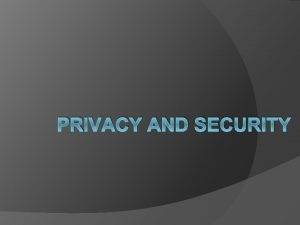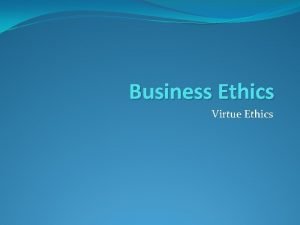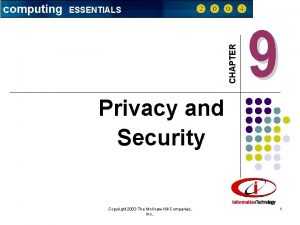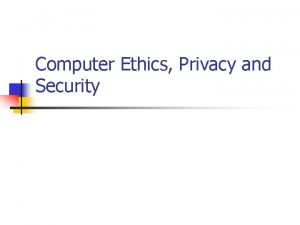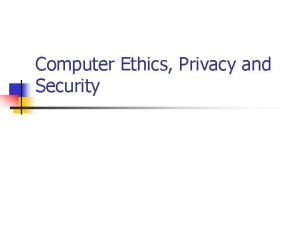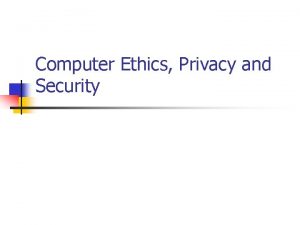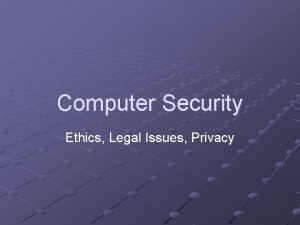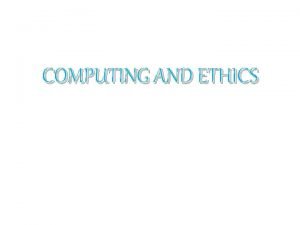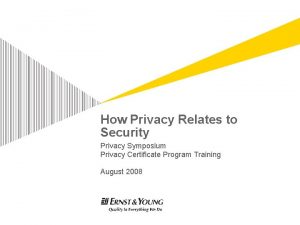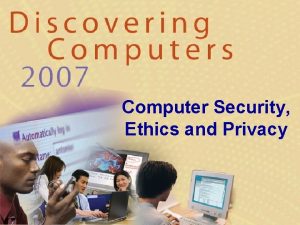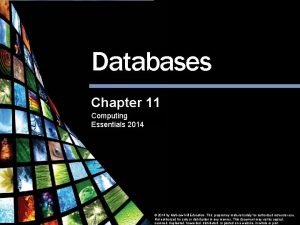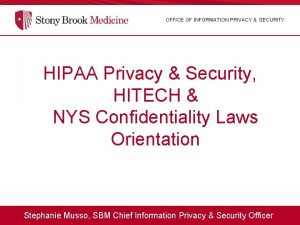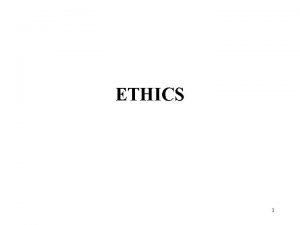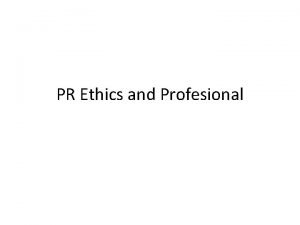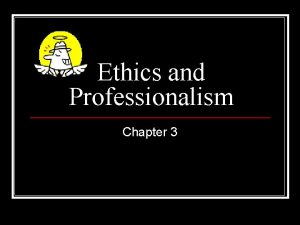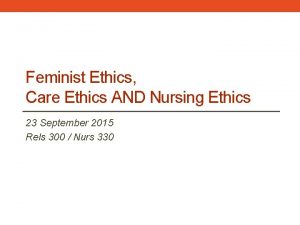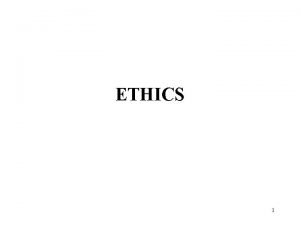Privacy Security and Ethics Computing Essentials 2014 Privacy



































































- Slides: 67

Privacy, Security, and Ethics Computing Essentials 2014 Privacy, Security and Ethics Computing Essentials 2014 © 2014 by Mc. Graw-Hill Education. This proprietary material solely for authorized instructor use. Not authorized for salefor or sale distribution in any manner. This document may notmay be copied, Not authorized or distribution in any manner. This document not be copied, scanned, duplicated, forwarded, distributed, or posted on a website, in whole or part.

Objectives (Page 1 of 3) § Identify the most significant concerns for effective implementation of computer technology. § Discuss the primary privacy issues of accuracy, property, and access. § Describe the impact of large databases, private networks, the Internet, and the Web on privacy. § Discuss online identity and major laws on privacy. Privacy, Security and Ethics Computing Essentials 2014 © 2014 by Mc. Graw-Hill Education. This proprietary material solely for authorized instructor use. Not authorized for sale or distribution in any manner. This document may not be copied, scanned, duplicated, forwarded, distributed, or posted on a website, in whole or part. 2

Objectives (Page 2 of 3) § Discuss cybercrimes including creation of malicious programs such as viruses, worms, Trojan horse, and zombies as well as denial of service attacks, Internet scams, social networking risks, cyberbullying, rogue Wi-Fi hotspots, theft, and data manipulation. § Detail ways to protect computer security including restricting access, encrypting data, anticipating disasters, and preventing data loss. Privacy, Security and Ethics Computing Essentials 2014 © 2014 by Mc. Graw-Hill Education. This proprietary material solely for authorized instructor use. Not authorized for sale or distribution in any manner. This document may not be copied, scanned, duplicated, forwarded, distributed, or posted on a website, in whole or part. 3

Objectives (Page 3 of 3) § Discuss computer ethics including copyright law, software piracy, digital rights management , the Digital Millennium Copyright Act, as well as plagiarism and ways to identify plagiarism. Privacy, Security and Ethics Computing Essentials 2014 © 2014 by Mc. Graw-Hill Education. This proprietary material solely for authorized instructor use. Not authorized for sale or distribution in any manner. This document may not be copied, scanned, duplicated, forwarded, distributed, or posted on a website, in whole or part. 4

People § Privacy – What are threats to personal privacy and how can we protect ourselves? § Security – How can access to sensitive information be controlled and how can we secure hardware and software? § Ethics – How do the actions of individual users and companies affect society? Privacy, Security and Ethics Computing Essentials 2014 © 2014 by Mc. Graw-Hill Education. This proprietary material solely for authorized instructor use. Not authorized for sale or distribution in any manner. This document may not be copied, scanned, duplicated, forwarded, distributed, or posted on a website, in whole or part. 5

Privacy § Privacy – concerns the collection and use of data about individuals § Three primary privacy issues: § Accuracy § Property § Access Privacy, Security and Ethics Computing Essentials 2014 © 2014 by Mc. Graw-Hill Education. This proprietary material solely for authorized instructor use. Not authorized for sale or distribution in any manner. This document may not be copied, scanned, duplicated, forwarded, distributed, or posted on a website, in whole or part. 6

Large Databases (Page 1 of 2) § Large organizations compile information about us. § Federal government has over 2, 000 databases § Telephone companies § Reverse directory lists of calls we make § Supermarkets § What we buy and when Privacy, Security and Ethics Computing Essentials 2014 © 2014 by Mc. Graw-Hill Education. This proprietary material solely for authorized instructor use. Not authorized for sale or distribution in any manner. This document may not be copied, scanned, duplicated, forwarded, distributed, or posted on a website, in whole or part. 7

Large Databases (Page 2 of 2) § Information resellers or information brokers § Collect and sell personal data § Electronic profiles easily created § Personal information is a marketable commodity, which raises many issues: § Collecting public, but personally identifying information (e. g. , Google’s Street View) § Spreading information without personal consent, leading to identity theft § Spreading inaccurate information § Mistaken identity § Freedom of Information Act Privacy, Security and Ethics Computing Essentials 2014 © 2014 by Mc. Graw-Hill Education. This proprietary material solely for authorized instructor use. Not authorized for sale or distribution in any manner. This document may not be copied, scanned, duplicated, forwarded, distributed, or posted on a website, in whole or part. 8

Private Networks § Employers can monitor e-mail legally § 75 percent of all businesses search employees’ electronic mail and computer files using snoopware § A proposed law could prohibit this type of electronic monitoring or at least require the employer to notify the employee first Privacy, Security and Ethics Computing Essentials 2014 © 2014 by Mc. Graw-Hill Education. This proprietary material solely for authorized instructor use. Not authorized for sale or distribution in any manner. This document may not be copied, scanned, duplicated, forwarded, distributed, or posted on a website, in whole or part. 9

Viewing and Blocking Cookies § Small pieces of information that are deposited on your hard disk from web sites you have visited § First-party cookies § Third-party cookies Privacy, Security and Ethics Computing Essentials 2014 © 2014 by Mc. Graw-Hill Education. This proprietary material solely for authorized instructor use. Not authorized for sale or distribution in any manner. This document may not be copied, scanned, duplicated, forwarded, distributed, or posted on a website, in whole or part. 10

Online Identity § The information that people voluntarily post about themselves online § Archiving and search features of the Web make it available indefinitely § Major Laws on Privacy § Gramm-Leach-Bliley Act § Health Insurance Portability and Accountability Act (HIPAA) § Family Educational Rights and Privacy Act (FERPA) Privacy, Security and Ethics Computing Essentials 2014 © 2014 by Mc. Graw-Hill Education. This proprietary material solely for authorized instructor use. Not authorized for sale or distribution in any manner. This document may not be copied, scanned, duplicated, forwarded, distributed, or posted on a website, in whole or part. 11

Security § Cybercrime or computer crime is any offense that involves a computer and a network § Hackers § Gain unauthorized access Privacy, Security and Ethics Computing Essentials 2014 © 2014 by Mc. Graw-Hill Education. This proprietary material solely for authorized instructor use. Not authorized for sale or distribution in any manner. This document may not be copied, scanned, duplicated, forwarded, distributed, or posted on a website, in whole or part. 12

Computer Security Risks What is a computer security risk? § Action that causes loss of or damage to computer system Privacy, Security and Ethics Computing Essentials 2014 © 2014 by Mc. Graw-Hill Education. This proprietary material solely for authorized instructor use. Not authorized for sale or distribution in any manner. This document may not be copied, scanned, duplicated, forwarded, distributed, or posted on a website, in whole or part.

Computer Crime (Page 1 of 3) § Malicious Programs - Malware § Viruses § Worms § Trojan horse § Zombies § Denial of Service § (Do. S) attack Privacy, Security and Ethics Computing Essentials 2014 © 2014 by Mc. Graw-Hill Education. This proprietary material solely for authorized instructor use. Not authorized for sale or distribution in any manner. This document may not be copied, scanned, duplicated, forwarded, distributed, or posted on a website, in whole or part. 14

Computer Viruses, Worms, and Trojan Horses What are viruses, worms, and Trojan horses? § Virus is a potentially damaging computer program (can spread and damage files) § Worm copies itself repeatedly, using up resources and possibly shutting down computer or network Privacy, Security and Ethics Computing Essentials 2014 © 2014 by Mc. Graw-Hill Education. This proprietary material solely for authorized instructor use. Not authorized for sale or distribution in any manner. This document may not be copied, scanned, duplicated, forwarded, distributed, or posted on a website, in whole or part.

Computer Viruses, Worms, and Trojan Horses § Payload (destructive event) that is delivered when you open file, run infected program, or boot computer with infected disk in disk drive § Trojan horse hides within or looks like legitimate program until triggered (does not replicate itself on other computers) Privacy, Security and Ethics Computing Essentials 2014 © 2014 by Mc. Graw-Hill Education. This proprietary material solely for authorized instructor use. Not authorized for sale or distribution in any manner. This document may not be copied, scanned, duplicated, forwarded, distributed, or posted on a website, in whole or part.

Computer Viruses, Worms, and Trojan Horses How can a virus spread through an e-mail message? Step 1. Unscrupulous programmers create a virus program. They hide the virus in a Word document and attach the Word document to an e -mail message. Step 2. They use the Internet to send the email message to thousands of users around the world. Privacy, Security and Ethics Computing Essentials 2014 © 2014 by Mc. Graw-Hill Education. This proprietary material solely for authorized instructor use. Not authorized for sale or distribution in any manner. This document may not be copied, scanned, duplicated, forwarded, distributed, or posted on a website, in whole or part.

Computer Viruses, Worms, and Trojan Horses Step 3 a. Some users open the attachment and their computers become infected with the virus. Step 3 b. Other users do not recognize the name of the sender of the e-mail message. These users do not open the e-mail message. Instead they delete the e-mail message. These users’ computers are not infected with the virus. Privacy, Security and Ethics Computing Essentials 2014 © 2014 by Mc. Graw-Hill Education. This proprietary material solely for authorized instructor use. Not authorized for sale or distribution in any manner. This document may not be copied, scanned, duplicated, forwarded, distributed, or posted on a website, in whole or part.

Computer Viruses, Worms, and Trojan Horses How can you protect your system from a macro virus? § Set macro security level in applications that allow you to write macros § At medium security level, warning displays that document contains macro § Macros are instructions saved in an application, such as word processing or spreadsheet program Privacy, Security and Ethics Computing Essentials 2014 © 2014 by Mc. Graw-Hill Education. This proprietary material solely for authorized instructor use. Not authorized for sale or distribution in any manner. This document may not be copied, scanned, duplicated, forwarded, distributed, or posted on a website, in whole or part.

Computer Viruses, Worms, and Trojan Horses What is an antivirus program? § Identifies and removes computer viruses § Most also protect against worms and Trojan horses § Popular Antivirus Programs § AVG Anti. Virus § Command Antivirus § Mc. Afee Virus Scan § Norton Antivirus § Trend Micro PC-cillin Privacy, Security and Ethics Computing Essentials 2014 © 2014 by Mc. Graw-Hill Education. This proprietary material solely for authorized instructor use. Not authorized for sale or distribution in any manner. This document may not be copied, scanned, duplicated, forwarded, distributed, or posted on a website, in whole or part.

Computer Viruses, Worms, and Trojan Horses What is a virus signature? § Specific pattern of virus code § Also called virus definition § Antivirus programs look for virus signatures Privacy, Security and Ethics Computing Essentials 2014 © 2014 by Mc. Graw-Hill Education. This proprietary material solely for authorized instructor use. Not authorized for sale or distribution in any manner. This document may not be copied, scanned, duplicated, forwarded, distributed, or posted on a website, in whole or part.

Computer Viruses, Worms, and Trojan Horses How does an antivirus program inoculate a program file? § Records information about program such as file size and creation date § Uses information to detect if virus tampers with file § Attempts to remove any detected virus § Quarantines infected files that it cannot remove § Keeps file in separate area of hard disk Privacy, Security and Ethics Computing Essentials 2014 © 2014 by Mc. Graw-Hill Education. This proprietary material solely for authorized instructor use. Not authorized for sale or distribution in any manner. This document may not be copied, scanned, duplicated, forwarded, distributed, or posted on a website, in whole or part.

Computer Viruses, Worms, and Trojan Horses What is a recovery disk? § Removable disk that contains uninfected copy of key operating system commands that enables computer to restart § Also called rescue disk § Once computer restarts, antivirus program can attempt to repair damaged files Privacy, Security and Ethics Computing Essentials 2014 © 2014 by Mc. Graw-Hill Education. This proprietary material solely for authorized instructor use. Not authorized for sale or distribution in any manner. This document may not be copied, scanned, duplicated, forwarded, distributed, or posted on a website, in whole or part.

Computer Viruses, Worms, and Trojan Horses What are some tips for preventing virus worm, and Trojan horse infections? § Set the macro security in programs so you can enable or disable macros § Install an antivirus program on all of your computers § Never open an e-mail attachment unless you are expecting it and it is from a trusted source Privacy, Security and Ethics Computing Essentials 2014 © 2014 by Mc. Graw-Hill Education. This proprietary material solely for authorized instructor use. Not authorized for sale or distribution in any manner. This document may not be copied, scanned, duplicated, forwarded, distributed, or posted on a website, in whole or part.

Computer Viruses, Worms, and Trojan Horses § If the antivirus program flags an e-mail attachment as infected, delete the attachment immediately § Check all downloaded programs for viruses, worms, or Trojan horses § Back up your files regularly Privacy, Security and Ethics Computing Essentials 2014 © 2014 by Mc. Graw-Hill Education. This proprietary material solely for authorized instructor use. Not authorized for sale or distribution in any manner. This document may not be copied, scanned, duplicated, forwarded, distributed, or posted on a website, in whole or part.

Denial of Service (Do. S) What is a denial of service attack? § Also called Do. S attack § Hacker uses unsuspecting computer, called zombie, to execute attack on other systems § Distributed Do. S (DDo. S) attack is more devastating Do. S attack in which multiple computers attack multiple networks § Computer Emergency Response Team Coordination Center (CERT/CC) assists with DDo. S attacks Privacy, Security and Ethics Computing Essentials 2014 © 2014 by Mc. Graw-Hill Education. This proprietary material solely for authorized instructor use. Not authorized for sale or distribution in any manner. This document may not be copied, scanned, duplicated, forwarded, distributed, or posted on a website, in whole or part.

Computer Crime (Page 2 of 3) § Internet scams § Phishing Privacy, Security and Ethics Computing Essentials 2014 © 2014 by Mc. Graw-Hill Education. This proprietary material solely for authorized instructor use. Not authorized for sale or distribution in any manner. This document may not be copied, scanned, duplicated, forwarded, distributed, or posted on a website, in whole or part. 27

Computer Crime - Unauthorized Access and Use What is unauthorized access and how is it achieved? § Use of a computer or network without permission § Hackers typically break into computer by connecting to it and then logging in as a legitimate user § Hacker, or cracker, is someone who tries to access a computer or network illegally Privacy, Security and Ethics Computing Essentials 2014 © 2014 by Mc. Graw-Hill Education. This proprietary material solely for authorized instructor use. Not authorized for sale or distribution in any manner. This document may not be copied, scanned, duplicated, forwarded, distributed, or posted on a website, in whole or part.

Computer Crime - Unauthorized Access and Use What is a firewall? § Security system consisting of hardware and/or software that prevents unauthorized network access Privacy, Security and Ethics Computing Essentials 2014 © 2014 by Mc. Graw-Hill Education. This proprietary material solely for authorized instructor use. Not authorized for sale or distribution in any manner. This document may not be copied, scanned, duplicated, forwarded, distributed, or posted on a website, in whole or part.

Computer Crime - Unauthorized Access and Use What is a personal firewall? § Program that protects personal computer and its data from unauthorized intrusions § Monitors transmissions to and from computer § Informs you of attempted intrusion Privacy, Security and Ethics Computing Essentials 2014 © 2014 by Mc. Graw-Hill Education. This proprietary material solely for authorized instructor use. Not authorized for sale or distribution in any manner. This document may not be copied, scanned, duplicated, forwarded, distributed, or posted on a website, in whole or part.

Computer Crime - Unauthorized Access and Use § Personal Firewall Software § Black. ICE PC Protection § Mc. Afee Firewall § Norton Personal Firewall § Sygate Personal Firewall § Tiny Personal Firewall § Zone. Alarm Privacy, Security and Ethics Computing Essentials 2014 © 2014 by Mc. Graw-Hill Education. This proprietary material solely for authorized instructor use. Not authorized for sale or distribution in any manner. This document may not be copied, scanned, duplicated, forwarded, distributed, or posted on a website, in whole or part.

Computer Crime - Unauthorized Access and Use What are other ways to protect your personal computer? § Disable file and printer sharing on Internet connection § Use online security service—Web site that evaluates computer to check for Web and e-mail vulnerabilities Privacy, Security and Ethics Computing Essentials 2014 © 2014 by Mc. Graw-Hill Education. This proprietary material solely for authorized instructor use. Not authorized for sale or distribution in any manner. This document may not be copied, scanned, duplicated, forwarded, distributed, or posted on a website, in whole or part.

Computer Crime - Unauthorized Access and Use How can companies protect against hackers? § Intrusion detection software analyzes network traffic, assesses system vulnerabilities, and identifies intrusions and suspicious behavior § Access control defines who can access computer and what actions they can take § Audit trail records access attempts Privacy, Security and Ethics Computing Essentials 2014 © 2014 by Mc. Graw-Hill Education. This proprietary material solely for authorized instructor use. Not authorized for sale or distribution in any manner. This document may not be copied, scanned, duplicated, forwarded, distributed, or posted on a website, in whole or part.

Computer Crime - Unauthorized Access and Use What is a user name? § Unique combination of characters that identifies user § Password is private combination of characters associated with the user name that allows access to computer resources Privacy, Security and Ethics Computing Essentials 2014 © 2014 by Mc. Graw-Hill Education. This proprietary material solely for authorized instructor use. Not authorized for sale or distribution in any manner. This document may not be copied, scanned, duplicated, forwarded, distributed, or posted on a website, in whole or part.

Computer Crime - Unauthorized Access and Use How can you make your password more secure? § Longer passwords provide greater security PASSWORD PROTECTION Privacy, Security and Ethics Computing Essentials 2014 © 2014 by Mc. Graw-Hill Education. This proprietary material solely for authorized instructor use. Not authorized for sale or distribution in any manner. This document may not be copied, scanned, duplicated, forwarded, distributed, or posted on a website, in whole or part.

Computer Crime - Unauthorized Access and Use What is a biometric device? § Authenticates person’s identity using personal characteristic § Fingerprint, hand geometry, voice, signature, and iris Privacy, Security and Ethics Computing Essentials 2014 © 2014 by Mc. Graw-Hill Education. This proprietary material solely for authorized instructor use. Not authorized for sale or distribution in any manner. This document may not be copied, scanned, duplicated, forwarded, distributed, or posted on a website, in whole or part.

Computer Crime - Unauthorized Access and Use What is a callback system? § User connects to computer only after the computer calls that user back at a previously established telephone number § Some networks utilize callback systems as an access control method to authenticate remote or mobile users § Callback systems work best for users who regularly work at the same remote location, such as at home or branch office Privacy, Security and Ethics Computing Essentials 2014 © 2014 by Mc. Graw-Hill Education. This proprietary material solely for authorized instructor use. Not authorized for sale or distribution in any manner. This document may not be copied, scanned, duplicated, forwarded, distributed, or posted on a website, in whole or part.

Computer Crime – Information Privacy § Social networking risks § Cyber-bullying § Rogue Wi-Fi hotspots § Theft § Data manipulation § Computer Fraud and Abuse Act Privacy, Security and Ethics Computing Essentials 2014 © 2014 by Mc. Graw-Hill Education. This proprietary material solely for authorized instructor use. Not authorized for sale or distribution in any manner. This document may not be copied, scanned, duplicated, forwarded, distributed, or posted on a website, in whole or part. 38

Information Privacy What is information privacy? § Right of individuals and companies to restrict collection and use of information about them § Difficult to maintain today because data is stored online § Employee monitoring is using computers to observe employee computer use § Legal for employers to use monitoring software programs Privacy, Security and Ethics Computing Essentials 2014 © 2014 by Mc. Graw-Hill Education. This proprietary material solely for authorized instructor use. Not authorized for sale or distribution in any manner. This document may not be copied, scanned, duplicated, forwarded, distributed, or posted on a website, in whole or part.

Information Privacy What are some ways to safeguard personal information? § Fill in necessary information on rebate, warranty, and registration forms § Install a cookie manager to filter cookies § Sign up for e-mail filtering through your Internet service provider or use an antispam program, such as Brightmail § Avoid shopping club and buyers cards Privacy, Security and Ethics Computing Essentials 2014 © 2014 by Mc. Graw-Hill Education. This proprietary material solely for authorized instructor use. Not authorized for sale or distribution in any manner. This document may not be copied, scanned, duplicated, forwarded, distributed, or posted on a website, in whole or part.

Information Privacy § Clear your history file when you are finished browsing § Inform merchants that you do not want them to distribute your personal information § Set up a free e-mail account; use this e-mail address for merchant forms § Do not reply to spam for any reason Privacy, Security and Ethics Computing Essentials 2014 © 2014 by Mc. Graw-Hill Education. This proprietary material solely for authorized instructor use. Not authorized for sale or distribution in any manner. This document may not be copied, scanned, duplicated, forwarded, distributed, or posted on a website, in whole or part.

Information Privacy § Turn off file and print sharing on your Internet connection § Surf the Web anonymously with a program such as Freedom Web Secure or through an anonymous Web site such as Anonymizer. com § Limit the amount of information you provide to Web sites; fill in only required information § Install a personal firewall Privacy, Security and Ethics Computing Essentials 2014 © 2014 by Mc. Graw-Hill Education. This proprietary material solely for authorized instructor use. Not authorized for sale or distribution in any manner. This document may not be copied, scanned, duplicated, forwarded, distributed, or posted on a website, in whole or part.

Information Privacy What is an electronic profile? § Data collected when you fill out form on Web § Merchants sell your electronic profile § Often you can specify whether you want personal information distributed Privacy, Security and Ethics Computing Essentials 2014 © 2014 by Mc. Graw-Hill Education. This proprietary material solely for authorized instructor use. Not authorized for sale or distribution in any manner. This document may not be copied, scanned, duplicated, forwarded, distributed, or posted on a website, in whole or part.

Information Privacy What is a cookie? § Small file on your computer that contains data about you § User preferences § How regularly you visit Web sites § Interests and browsing habits § Some Web sites sell or trade information stored in your cookies § Set browser to accept cookies, prompt you to accept cookies, or disable cookies Privacy, Security and Ethics Computing Essentials 2014 © 2014 by Mc. Graw-Hill Education. This proprietary material solely for authorized instructor use. Not authorized for sale or distribution in any manner. This document may not be copied, scanned, duplicated, forwarded, distributed, or posted on a website, in whole or part.

Information Privacy How do cookies work? § Step 1. When you type Web address of Web site in your browser window, browser program searches your hard disk for a cookie associated with Web site. § Step 2. If browser finds a cookie, it sends information in cookie file to Web site. § Step 3. If Web site does not receive cookie information, and is expecting it, Web site creates an identification number for you in its database and sends that number to your browser. Browser in turn creates a cookie file based on that number and stores cookie file on your hard disk. Web site now can update information in cookie files whenever you access the site Privacy, Security and Ethics Computing Essentials 2014 © 2014 by Mc. Graw-Hill Education. This proprietary material solely for authorized instructor use. Not authorized for sale or distribution in any manner. This document may not be copied, scanned, duplicated, forwarded, distributed, or posted on a website, in whole or part.

Information Privacy What is a cookie manager? § Software program that selectively blocks cookies. Privacy, Security and Ethics Computing Essentials 2014 © 2014 by Mc. Graw-Hill Education. This proprietary material solely for authorized instructor use. Not authorized for sale or distribution in any manner. This document may not be copied, scanned, duplicated, forwarded, distributed, or posted on a website, in whole or part.

Information Privacy What are spyware and spam? § Spyware is program placed on computer without user’s knowledge § Secretly collects information about user § Spam is unsolicited e-mail message sent to many recipients Privacy, Security and Ethics Computing Essentials 2014 © 2014 by Mc. Graw-Hill Education. This proprietary material solely for authorized instructor use. Not authorized for sale or distribution in any manner. This document may not be copied, scanned, duplicated, forwarded, distributed, or posted on a website, in whole or part.

Information Privacy How can you control spam? § E-mail filtering § Service that blocks e-mail messages from designated sources § Collects spam in central location that you can view any time § Anti-spam program § Attempts to remove spam § Sometimes removes valid e-mail messages Privacy, Security and Ethics Computing Essentials 2014 © 2014 by Mc. Graw-Hill Education. This proprietary material solely for authorized instructor use. Not authorized for sale or distribution in any manner. This document may not be copied, scanned, duplicated, forwarded, distributed, or posted on a website, in whole or part.

Information Privacy What privacy laws have been enacted? • 1992 Cable Act Extends the privacy of the Cable Communications Policy Act of 1984 to include cellular and other wireless services. • 1994 Computer Abuse Amendments Act Amends 1984 act to outlaw transmission of harmful computer code such as viruses. • 1996 National Information Intrastructure Protection Act Penalizes theft of information across state lines, threats against networks, and computer system trespassing. Privacy, Security and Ethics Computing Essentials 2014 © 2014 by Mc. Graw-Hill Education. This proprietary material solely for authorized instructor use. Not authorized for sale or distribution in any manner. This document may not be copied, scanned, duplicated, forwarded, distributed, or posted on a website, in whole or part.

Information Privacy What privacy laws have been enacted? § 1997 No Electronic Theft Act Closes a narrow loophole in the law that allowed people to give away copyrighted materials (such as software) on the Internet without legal repercussions. § 1998 Digital Millennium Copyright Act Makes it illegal to circumvent antipiracy scheme in commercial software: outlaws sale of devices that copy software illegally. § 2001 Provide Appropriate Tools Required to Intercept and Obstruct Terrorism (Patriot Act) Gives law enforcement the right to monitor people’s activities, including Web and e-mail habits. Privacy, Security and Ethics Computing Essentials 2014 © 2014 by Mc. Graw-Hill Education. This proprietary material solely for authorized instructor use. Not authorized for sale or distribution in any manner. This document may not be copied, scanned, duplicated, forwarded, distributed, or posted on a website, in whole or part.

Information Privacy What is content filtering? § Process of restricting access to certain material § Internet Content Rating Association (ICRA) provides rating system of Web content § Web filtering software restricts access to specified sites Privacy, Security and Ethics Computing Essentials 2014 © 2014 by Mc. Graw-Hill Education. This proprietary material solely for authorized instructor use. Not authorized for sale or distribution in any manner. This document may not be copied, scanned, duplicated, forwarded, distributed, or posted on a website, in whole or part.

Health Concerns of Computer Use What are some health concerns of computer use? § Computer vision syndrome (CVS)—eye and vision problems § Repetitive strain injury (RSI) § Carpal tunnel syndrome (CTS)— inflammation of nerve that connects forearm to palm Privacy, Security and Ethics Computing Essentials 2014 © 2014 by Mc. Graw-Hill Education. This proprietary material solely for authorized instructor use. Not authorized for sale or distribution in any manner. This document may not be copied, scanned, duplicated, forwarded, distributed, or posted on a website, in whole or part.

Health Concerns of Computer Use § Tendonitis—inflammation of tendon due Tendonitis to repeated motion § Computer addiction—when computer addiction consumes entire social life Privacy, Security and Ethics Computing Essentials 2014 © 2014 by Mc. Graw-Hill Education. This proprietary material solely for authorized instructor use. Not authorized for sale or distribution in any manner. This document may not be copied, scanned, duplicated, forwarded, distributed, or posted on a website, in whole or part.

Health Concerns of Computer Use What precautions can prevent tendonitis or carpal tunnel syndrome? § Take frequent breaks during computer session § Use wrist rest § Exercise hands and arms § Minimize number of times you switch between mouse and keyboard Privacy, Security and Ethics Computing Essentials 2014 © 2014 by Mc. Graw-Hill Education. This proprietary material solely for authorized instructor use. Not authorized for sale or distribution in any manner. This document may not be copied, scanned, duplicated, forwarded, distributed, or posted on a website, in whole or part.

Health Concerns of Computer Use How can you ease eyestrain when working at the computer? § Every 10 to 15 minutes take an eye break § Look into the distance and focus on an object for 20 to 30 seconds § Roll your eyes in a complete circle § Close your eyes and rest them for at least one minute Privacy, Security and Ethics Computing Essentials 2014 © 2014 by Mc. Graw-Hill Education. This proprietary material solely for authorized instructor use. Not authorized for sale or distribution in any manner. This document may not be copied, scanned, duplicated, forwarded, distributed, or posted on a website, in whole or part.

Health Concerns of Computer Use § Blink your eyes every five seconds § Place your display device about an arm’s length away from your eyes with the top of the screen at eye level or below § Use large fonts § If you wear glasses, ask your doctor about computer glasses § Adjust the lighting Privacy, Security and Ethics Computing Essentials 2014 © 2014 by Mc. Graw-Hill Education. This proprietary material solely for authorized instructor use. Not authorized for sale or distribution in any manner. This document may not be copied, scanned, duplicated, forwarded, distributed, or posted on a website, in whole or part.

Health Concerns of Computer Use What is ergonomics? § Applied science devoted to comfort, efficiency, and safety in workplace § Keyboard height: 23” to 28” § Elbows at 90 degrees and arms and hands parallel to the floor § Adjustable backrest § Adjustable seat § Feet flat on floor § Adjustable height chair with 5 legs for stability Privacy, Security and Ethics Computing Essentials 2014 © 2014 by Mc. Graw-Hill Education. This proprietary material solely for authorized instructor use. Not authorized for sale or distribution in any manner. This document may not be copied, scanned, duplicated, forwarded, distributed, or posted on a website, in whole or part.

Health Concerns of Computer Use What is green computing? § Reducing electricity and environmental waste while using computer § Use computer and devices that comply with the ENERGY STAR program. § Do not leave the computer running overnight. § Turn off the monitor, printer, and other devices when not in use. Privacy, Security and Ethics Computing Essentials 2014 © 2014 by Mc. Graw-Hill Education. This proprietary material solely for authorized instructor use. Not authorized for sale or distribution in any manner. This document may not be copied, scanned, duplicated, forwarded, distributed, or posted on a website, in whole or part.

Health Concerns of Computer Use § Use paperless methods to communicate § Recycle paper § Buy recycle paper § Recycle toner cartridges § Recycle old computers and printers § Telecommute (save gas) Privacy, Security and Ethics Computing Essentials 2014 © 2014 by Mc. Graw-Hill Education. This proprietary material solely for authorized instructor use. Not authorized for sale or distribution in any manner. This document may not be copied, scanned, duplicated, forwarded, distributed, or posted on a website, in whole or part.

Ethics § Copyright § Gives content creators the right to control the use and distribution of their work § Paintings, books, music, films, video games § Software piracy § Unauthorized copying and distribution § Plagiarism Privacy, Security and Ethics Computing Essentials 2014 © 2014 by Mc. Graw-Hill Education. This proprietary material solely for authorized instructor use. Not authorized for sale or distribution in any manner. This document may not be copied, scanned, duplicated, forwarded, distributed, or posted on a website, in whole or part. 60

Ethics and Society What are computer ethics? § Moral guidelines that govern use of computers and information systems § Unauthorized use of computers and networks § Software theft § Information accuracy § Intellectual property rights—rights to which creators are entitled for their work § Codes of conduct § Information privacy Privacy, Security and Ethics Computing Essentials 2014 © 2014 by Mc. Graw-Hill Education. This proprietary material solely for authorized instructor use. Not authorized for sale or distribution in any manner. This document may not be copied, scanned, duplicated, forwarded, distributed, or posted on a website, in whole or part.

Ethics and Society What is an IT code of conduct? § Written guideline that helps determine whether computer action is ethical § Employers can distribute to employees IT CODE OF CONDUCT Privacy, Security and Ethics Computing Essentials 2014 © 2014 by Mc. Graw-Hill Education. This proprietary material solely for authorized instructor use. Not authorized for sale or distribution in any manner. This document may not be copied, scanned, duplicated, forwarded, distributed, or posted on a website, in whole or part.

Careers in IT § IT Security Analysts maintain the security of a company’s network, systems, and data. § Must safeguard information systems against external threats § Annual salary is usually from $62, 000 to $101, 000 § Demand for this position is expected to grow Privacy, Security and Ethics Computing Essentials 2014 © 2014 by Mc. Graw-Hill Education. This proprietary material solely for authorized instructor use. Not authorized for sale or distribution in any manner. This document may not be copied, scanned, duplicated, forwarded, distributed, or posted on a website, in whole or part. 63

A Look to the Future § A Webcam on Every Corner § Images of public places are more accessible than ever before (e. g. , Google Street View) § “Virtual site-seeing tours” § Public webcams continue to grow in popularity Privacy, Security and Ethics Computing Essentials 2014 © 2014 by Mc. Graw-Hill Education. This proprietary material solely for authorized instructor use. Not authorized for sale or distribution in any manner. This document may not be copied, scanned, duplicated, forwarded, distributed, or posted on a website, in whole or part. 64

Open-Ended Questions (Page 1 of 3) § Define privacy and discuss the impact of large databases, private networks, the Internet, and the Web. § Define and discuss online identity and the major privacy laws. § Define security. Define computer crime and the impact of malicious programs, including viruses, worms, Trojan horses, and zombies, as well as cyberbullying, denial of service attacks, Internet scams, social networking risks, rogue Wi-Fi hotspots, thefts, data manipulation, and other hazards. Privacy, Security and Ethics Computing Essentials 2014 © 2014 by Mc. Graw-Hill Education. This proprietary material solely for authorized instructor use. Not authorized for sale or distribution in any manner. This document may not be copied, scanned, duplicated, forwarded, distributed, or posted on a website, in whole or part. 65

Open-Ended Questions (Page 2 of 2) § Discuss ways to protect computer security including restricting access, encrypting data, anticipating disasters, and preventing data loss. § Define ethics, and describe copyright law and plagiarism. Privacy, Security and Ethics Computing Essentials 2014 © 2014 by Mc. Graw-Hill Education. This proprietary material solely for authorized instructor use. Not authorized for sale or distribution in any manner. This document may not be copied, scanned, duplicated, forwarded, distributed, or posted on a website, in whole or part. 66

Making IT Work for You ~ Cloud-Based Backup § Cloud-based backup services such as Carbonite provide cloudbased backup services. Privacy, Security and Ethics Computing Essentials 2014 © 2014 by Mc. Graw-Hill Education. This proprietary material solely for authorized instructor use. Not authorized for sale or distribution in any manner. This document may not be copied, scanned, duplicated, forwarded, distributed, or posted on a website, in whole or part. 67
 Chapter 9 privacy security and ethics
Chapter 9 privacy security and ethics Chapter 9 privacy security and ethics
Chapter 9 privacy security and ethics Chapter 9 privacy security and ethics
Chapter 9 privacy security and ethics Destructive event or prank a virus was created to deliver
Destructive event or prank a virus was created to deliver Cvs privacy awareness and hipaa training answers
Cvs privacy awareness and hipaa training answers Windows essentials 2014
Windows essentials 2014 Windows essentials 2014
Windows essentials 2014 Private securit
Private securit Microsoft from back doors gov active
Microsoft from back doors gov active Hipaa privacy and security awareness training
Hipaa privacy and security awareness training William stallings network security essentials 5th edition
William stallings network security essentials 5th edition Kr
Kr Cissp guide to security essentials
Cissp guide to security essentials Cissp guide to security essentials
Cissp guide to security essentials Cryptographic systems are generically classified by
Cryptographic systems are generically classified by Conventional computing and intelligent computing
Conventional computing and intelligent computing Aca code of ethics 2014
Aca code of ethics 2014 Differentiate micro-ethics and macro-ethics.
Differentiate micro-ethics and macro-ethics. State legal, ethical and professional aspects of security.
State legal, ethical and professional aspects of security. Computer ethics and cyber security
Computer ethics and cyber security Descriptive ethics
Descriptive ethics Realism vs anti realism
Realism vs anti realism Valuing time in professional ethics
Valuing time in professional ethics Metaethics vs normative ethics
Metaethics vs normative ethics Descriptive ethics vs normative ethics
Descriptive ethics vs normative ethics Descriptive ethics vs normative ethics
Descriptive ethics vs normative ethics Theological voluntarism
Theological voluntarism Metaethics vs normative ethics
Metaethics vs normative ethics Deontology examples
Deontology examples Teleological ethics vs deontological ethics
Teleological ethics vs deontological ethics Security in computing 5th edition ppt
Security in computing 5th edition ppt Security in computing pfleeger
Security in computing pfleeger Security in computing 5th edition answers
Security in computing 5th edition answers Grid computing security
Grid computing security Nist cloud architecture
Nist cloud architecture Cloud cube model
Cloud cube model Security problems in computing
Security problems in computing Wireless security in cryptography and network security
Wireless security in cryptography and network security Electronic commerce security
Electronic commerce security Ethics in security management
Ethics in security management What is osi security architecture
What is osi security architecture Security guide to network security fundamentals
Security guide to network security fundamentals Explain about visa international security mode
Explain about visa international security mode Electronic mail security in network security
Electronic mail security in network security Cnss security model 27 cells example
Cnss security model 27 cells example Seven touchpoints for software security
Seven touchpoints for software security Security guide to network security fundamentals
Security guide to network security fundamentals Security guide to network security fundamentals
Security guide to network security fundamentals Safeguarding and child protection the essentials
Safeguarding and child protection the essentials Cisco it essentials pc hardware and software
Cisco it essentials pc hardware and software Essentials of business and online commerce law
Essentials of business and online commerce law Structure of drama
Structure of drama Essentials of nursing leadership and management
Essentials of nursing leadership and management Web essentials clients servers and communication
Web essentials clients servers and communication Essentials of systems analysis and design
Essentials of systems analysis and design Strength training ne demek
Strength training ne demek It essentials pc hardware and software
It essentials pc hardware and software Graphic design essentials
Graphic design essentials Operant conditioning definition
Operant conditioning definition It essentials pc hardware and software
It essentials pc hardware and software Care certificate privacy and dignity answers
Care certificate privacy and dignity answers Ferpa
Ferpa Family educational rights and privacy act of 1974
Family educational rights and privacy act of 1974 Confidentiality and privacy controls
Confidentiality and privacy controls Three primary privacy issues are accuracy property and
Three primary privacy issues are accuracy property and Social services and wellbeing (wales) act 2014 easy read
Social services and wellbeing (wales) act 2014 easy read Social services and wellbeing (wales) act 2014 easy read
Social services and wellbeing (wales) act 2014 easy read Veterinary nurse conduct and discipline rules 2014
Veterinary nurse conduct and discipline rules 2014
